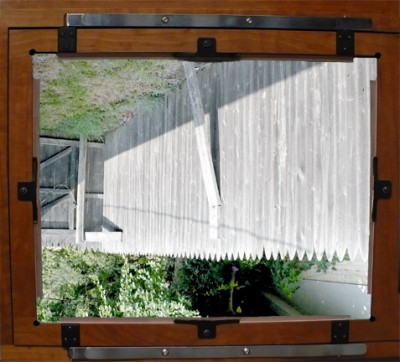 Seems that a large view camera always attracts curiosity. Everyone either gives you a long wondering look or asks questions about that big box on a tripod. Mostly they want to know how old the camera is and if you can still buy film. Is that a Hasselblad is a question that comes up from time to time?
Seems that a large view camera always attracts curiosity. Everyone either gives you a long wondering look or asks questions about that big box on a tripod. Mostly they want to know how old the camera is and if you can still buy film. Is that a Hasselblad is a question that comes up from time to time?
For those that are truly interested, a peek under the dark cloth is always a good way to confuse them even more. The first thing they do is stick their nose right up against the ground glass. With that point blank view you see nothing. I have to explain that they need to back up. That it is like looking at a TV screen. After getting a good look they suddenly realize everything is upside down. I have to explain that it is also reversed left to right. Comments range from silence to questions about how can you do anything when the world is upside down and reversed? I usual just say that you get used to it and it becomes part of how you and the camera work.
The truth is, nothing will improve your overall composition more than looking at it upside down. It is a way to trick your left brain into shutting up and allowing your right brain to take over. The left brain is your engineering side. . . it deals with facts and figures. Your right brain is the creative side. . . it deals with form and shape. We are taught from an early age to be left brain dominant, so we get used to ignoring our creative side. The quickest way to shut your left brain up is to show it something it cannot readily identify. With the composition upside down, the right brain is in its natural environment and unimpeded by the chatter from the left side.
>With the inverted view on the ground glass it seems that the subconscious sees things that the conscious mind does not pick up on. I see things on the ground glass that are interesting, they have absolutely no meaning, yet there is something inside that says this is something of interest. There are abstract images that I have made that did not register until I looked at the proofs. There are times that something just calls out to be framed and photographed. It may have no rhyme or reason at the time of exposure, but later becomes something of great interest, even something totally different than originally envisioned.
Do not be afraid of the inverted image. It is one of the most powerful assets you have when making photographs. You will quickly get used to seeing things this way. It rapidly becomes part of your connection to the camera and your subject. Do I recommend you get one of those reflex viewing hoods that turn things back around? Absolutely NOT!
Quit fighting what comes naturally and allow your creativity to flow from within. Quit trying to analyze the subject and allow that inverted view to work its own magic. As I said earlier; Nothing will improve your overall composition more than looking at it upside down.
JB
JB
